Mobile DOAS Observations of Tropospheric NO2 Using an UltraLight Trike and Flux Calculation
Abstract
:1. Introduction
2. Methodology
2.1. Experimental and Instrumental Descriptions
2.2. Determination of the NO2 Tropospheric Vertical Column and Flux Calculation
2.2.1. Retrieval of NO2 Slant Column
2.2.2. Deduction of the SCDref and VCDstrato
2.2.3. Radiative Transfer Calculation
3. Results and Discussions
NO2 Flux Calculation
4. Conclusions
Acknowledgments
Author Contributions
Conflicts of Interest
References
- Solomon, S.; Portmann, R.W.; Sanders, R.W.; Daniel, J.S.; Madsen, W.; Bartram, B.; Dutton, E.G. On the role of nitrogen dioxide in the absorption of solar radiation. J. Geophys. Res. 1999, 104, 12047–12058. [Google Scholar] [CrossRef]
- Platt, U. Differential optical absorption spectroscopy (DOAS). Chem. Anal. Ser. 1994, 127, 27–83. [Google Scholar]
- Brewer, A.W.; McElroy, C.T.; Kerr, J.B. Nitrogen dioxide concentration in the atmosphere. Nature 1973, 246, 129–133. [Google Scholar] [CrossRef]
- Noxon, J.F. Nitrogen dioxide in the stratosphere and troposphere measured by ground-based absorption spectroscopy. Science 1975, 189, 547–549. [Google Scholar] [CrossRef] [PubMed]
- Hendrick, F.; Müller, J.-F.; Clémer, K.; Wang, P.; De Mazière, M.; Fayt, C.; Gielen, C.; Hermans, C.; Ma, J.Z.; Pinardi, G.; et al. Four years of ground-based MAX-DOAS observations of HONO and NO2 in the Beijing area. Atmos. Chem. Phys. 2014, 14, 765–781. [Google Scholar] [CrossRef]
- Constantin, D.-E.; Merlaud, A.; van Roozendael, M.; Voiculescu, M.; Fayt, C.; Hendrick, F.; Pinardi, G.; Georgescu, L. Measurements of Tropospheric NO2 in Romania Using a Zenith-Sky Mobile DOAS System and Comparisons with Satellite Observations. Sensors 2013, 13, 3922–3940. [Google Scholar] [CrossRef]
- Dragomir, C.; Constantin, D.-E.; Voiculescu, M.; Georgescu, L.; Merlaud, A.; Roozendael, M.V. Modeling results of atmospheric dispersion of NO2 in an urban area using METI–LIS and comparison with coincident mobile DOAS measurements. Atmos. Pollut. Res. 2015, 6, 503–510. [Google Scholar] [CrossRef]
- Merlaud, A.; van Roozendael, M.; van Gent, J.; Fayt, C.; Maes, J.; Toledo-Fuentes, X.; Ronveaux, O.; de Mazière, M. DOAS measurements of NO2 from an ultralight aircraft during the Earth Challenge expedition. Atmos. Meas. Tech. 2012, 5, 2057–2068. [Google Scholar] [CrossRef]
- Meier, A.C.; Schönhardt, A.; Bösch, T.; Richter, A.; Seyler, A.; Ruhtz, T.; Constantin, D.-E.; Shaiganfar, R.; Wagner, T.; Merlaud, A.; et al. High-resolution airborne imaging DOAS-measurements of NO2 above Bucharest during AROMAT. Atmos. Meas. Tech. Discuss. 2016. [Google Scholar] [CrossRef]
- Tack, F.; Merlaud, A.; Iordache, M.-D.; Danckaert, T.; Yu, H.; Fayt, C.; Meuleman, K.; Deutsch, F.; Fierens, F.; van Roozendael, M. High resolution mapping of the NO2 spatial distribution over Belgian urban areas based on airborne APEX remote sensing. Atmos. Meas. Tech. Discuss. 2017. [Google Scholar] [CrossRef]
- Merlaud, A.; Constantin, D.; Fayt, C.; Maes, J.; Mingireanu, F.; Mocanu, I.; Georgescu, L.; Roozendael, M. Small whiskbroom imager for atmospheric composition monitoring (SWING) from an unmanned areal vehicle (UAV). In Proceedings of the 21st ESA Symposium on European Rocket and Balloon Programmes and related Research, Thun, Switzerland, 9–13 June 2014; pp. 1–7. [Google Scholar]
- Bovensmann, H.; Burrows, J.P.; Buchwitz, M.; Frerick, J.; Nöel, S.; Rozanov, V.V.; Chance, K.V.; Goede, A.H.P. SCIAMACHY—Mission objectives and measurement modes. J. Atmos. Sci. 1999, 56, 127–150. [Google Scholar] [CrossRef]
- Levelt, P.; van den Oord, G.; Dobber, M.; Malkki, A.; Visser, H.; de Vries, J.; Stammes, P.; Lundell, J.; Saari, H. The ozone monitoring instrument. IEEE T. Geosci. Remote. 2006, 44, 1093–1101. [Google Scholar] [CrossRef]
- Munro, R.; Eisinger, M.; Anderson, C.; Callies, J.; Corpaccioli, E.; Lang, R.; Lefebvre, A.; Livschitz, Y.; Albinana, A.P. GOME-2 on MetOp. In Proceedings of the 2006 EUMETSAT Meteorological Satellite Conference, Helsinki, Finland, 12–16 June 2006; p. 48. [Google Scholar]
- van der A, R.J.; Eskes, H.J.; Boersma, K.F.; van Noije, T.P.C.; van Roozendael, M.; de Smedt, I.; Peters, D.H.M.U.; Meijer, E.W. Trends, seasonal variability and dominant NOx source derived from a ten year record of NO2 measured from space. J. Geophys. Res. 2008, 113, D04302. [Google Scholar] [CrossRef]
- Varotsos, C.; Christodoulakis, J.; Tzanis, C.; Cracknell, A.P. Signature of tropospheric ozone and nitrogen dioxide from space: A case study for Athens, Greece. Atmos. Environ. 2014, 89, 721–730. [Google Scholar] [CrossRef]
- Junkermann, W. An ultralight aircraft as platform for research in the lower troposphere: System performance and first results from radiation transfer studies in stratiform aerosol layers and broken cloud conditions. J. Atmos. Ocean. Technol. 2001, 18, 934. [Google Scholar] [CrossRef]
- Junkermann, W. On the distribution of formaldehyde in the western Po-Valley, Italy, during FORMAT 2002/2003. Atmos. Chem. Phys. 2009, 9, 9187–9196. [Google Scholar] [CrossRef]
- Chazette, P.; Sanak, J.; Dulac, F. New Approach for Aerosol Profiling with a Lidar Onboard an Ultralight Aircraft: Application to the African Monsoon Multidisciplinary Analysis. Environ. Sci. Technol. 2007, 41, 8335–8341. [Google Scholar] [CrossRef] [PubMed]
- Wang, P.; Richter, A.; Bruns, M.; Burrows, J.P.; Scheele, R.; Junkermann, W.; Heue, K.-P.; Wagner, T.; Platt, U.; Pundt, I. Airborne multi-axis DOAS measurements of tropospheric SO2 plumes in the Po-valley, Italy. Atmos. Chem. Phys. 2006, 6, 329–338. [Google Scholar] [CrossRef]
- Grutter, M.; Basaldud, R.; Rivera, C.; Harig, R.; Junkerman, W.; Caetano, E.; Delgado-Granados, H. SO2 emissions from Popocatépetl volcano: Emission rates and plume imaging using optical remote sensing techniques. Atmos. Chem. Phys. 2008, 8, 6655–6663. [Google Scholar] [CrossRef]
- General, S.; Pöhler, D.; Sihler, H.; Bobrowski, N.; Frieß, U.; Zielcke, J.; Horbanski, M.; Shepson, P.B.; Stirm, B.H.; Simpson, W.R.; et al. The Heidelberg Airborne Imaging DOAS Instrument (HAIDI)—A novel imaging DOAS device for 2-D and 3-D imaging of trace gases and aerosols. Atmos. Meas. Tech. 2014, 7, 3459–3485. [Google Scholar] [CrossRef]
- Liu, L.; Flatøy, F.; Ordóñez, C.; Braathen, G.O.; Hak, C.; Junkermann, W.; Andreani-Aksoyoglu, S.; Mellqvist, J.; Galle, B.; Prévôt, A.S.H.; et al. Photochemical modelling in the Po basin with focus on formaldehyde and ozone. Atmos. Chem. Phys. 2007, 7, 121–137. [Google Scholar] [CrossRef]
- Airborne Romanian Measurements of Aerosols and Trace Gases (AROMAT). Available online: http://uv-vis.aeronomie.be/aromat/index.php (accessed on 15 January 2017).
- Danckaert, T.; Fayt, C.; van Roozendael, M.; de Smedt, I.; Letocart, V.; Merlaud, A.; Pinardi, G. QDOAS Software user manual Version 2.111-April 2016, UV-Visible DOAS Research Group of the Royal Belgian Institute for Space Aeronomy Web Site. Available online: http://uv-vis.aeronomie.be/software/QDOAS/QDOAS_manual.pdf (accessed on 15 December 2016).
- Vandaele, A.; Hermans, C.; Simon, P.; Carleer, M.; Colin, R.; Fally, S.; Mérienne, F.; Jenouvrier, A.; Coquart, B. Measurements of the NO2 absorption cross-section from 42000 cm−1 to 10000 cm−1 (238–1000 nm) at 220 K and 294 K (220 K). J. Quant. Spectrosc. Radiat. Transf. 1998, 59, 171–184. [Google Scholar] [CrossRef]
- Bogumil, K.; Orphal, J.; Homann, T.; Voigt, S.; Spietz, P.; Fleischmann, O.C.; Vogel, A.; Hartmann, M.; Kromminga, H.; Bovensmann, H.; et al. Measurements of molecular absorption spectra with the SCIAMACHY pre-flight model: Instrument characterization and reference data for atmospheric remote-sensing in the 230–2380 nm region. J. Photochem. Photobiol. A Chem. 2003, 157, 167–184. [Google Scholar] [CrossRef]
- Thalman, R.; Volkamer, R. Temperature dependent absorption cross-sections of O2-O2 collision pairs between 340 and 630 nm and at atmospherically relevant pressure. Phys. Chem. Chem. Phys. 2013, 15, 15371–15381. [Google Scholar] [CrossRef] [PubMed]
- Chance, K.V.; Spurr, R.J.D. Ring effect studies: Rayleigh scattering, including molecular parameters for rotational Raman scattering, and the Fraunhofer spectrum. Appl. Opt. 1997, 36, 5224–5230. [Google Scholar] [CrossRef] [PubMed]
- Baidar, S.; Oetjen, H.; Coburn, S.; Dix, B.; Ortega, I.; Sinreich, R.; Volkamer, R. The CU Airborne MAX-DOAS instrument: Vertical profiling of aerosol extinction and trace gases. Atmos. Meas. Tech. 2013, 6, 719–739. [Google Scholar] [CrossRef]
- Vaughan, G.; Quinn, P.T.; Green, A.C.; Bean, J.; Roscoe, H.K.; van Roozendael, M.; Goutail, F. SAOZ measurements of stratospheric NO2 at Aberystwyth. J. Environ. Monit. 2006, 8, 353–361. [Google Scholar] [CrossRef] [PubMed]
- Dirksen, R.J.; Boersma, K.F.; Eskes, H.J.; Ionov, D.V.; Bucsela, E.J.; Levelt, P.F.; Kelder, H.M. Evaluation of stratospheric NO2 retrieved from the Ozone Monitoring Instrument: Intercomparison, diurnal cycle and trending. J. Geophys. Res. 2011, 116, D08305. [Google Scholar] [CrossRef]
- Hendrick, F.; Barret, B.; van Roozendael, M.; Boesch, H.; Butz, A.; De Mazière, M.; Goutail, F.; Hermans, C.; Lambert, J.-C.; Pfeilsticker, K.; et al. Retrieval of nitrogen dioxide stratospheric profiles from ground-based zenith-sky UV-visible observations: Validation of the technique through correlative comparisons. Atmos. Chem. Phys. 2004, 4, 2091–2106. [Google Scholar] [CrossRef]
- Hendrick, F.; van Roozendael, M.; Kylling, A.; Petritoli, A.; Rozanov, A.; Sanghavi, S.; Schofield, R.; von Friedeburg, C.; Wagner, T.; Wittrock, F.; et al. Intercomparison exercise between different radiative transfer models used for the interpretation of ground-based zenith-sky and multi-axis DOAS observations. Atmos. Chem. Phys. 2006, 6, 93–108. [Google Scholar] [CrossRef]
- Mayer, B.; Kylling, A. Technical note: The libRadtran software package for radiative transfer calculations—description and examples of use. Atmos. Chem. Phys. 2005, 5, 1855–1877. [Google Scholar] [CrossRef]
- Rivera, C.; Sosa, G.; Wöhrnschimmel, H.; de Foy, B.; Johansson, M.; Galle, B. Tula industrial complex (Mexico) emissions of SO2 and NO2 during the MCMA 2006 field campaign using a mobile mini-DOAS system. Atmos. Chem. Phys. 2009, 9, 6351–6361. [Google Scholar] [CrossRef]
- Johansson, M.; Rivera, C.; de Foy, B.; Lei, W.; Song, J.; Zhang, Y.; Galle, B.; Molina, L. Mobile mini-DOAS measurement of the outflow of NO2 and HCHO from Mexico City. Atmos. Chem. Phys. 2009, 9, 5647–5653. [Google Scholar] [CrossRef]
- Stein, A.F.; Draxler, R.R.; Rolph, G.D.; Stunder, B.J.B.; Cohen, M.D.; Ngan, F. NOAA‘s HYSPLIT atmospheric transport and dispersion modeling system. Bull. Am. Meteorol. Soc. 2015, 96, 2059–2077. [Google Scholar] [CrossRef]
- Studiu Privind Calitatea Aerului in Municipiul Galati; Municipiul Galati: Galati, Romania, 2016.
- Frins, E.; Bobrowski, N.; Osorio, M.; Casaballe, N.; Belsterli, G.; Wagner, T.; Platt, U. Scanning and mobile multi-axis DOAS measurements of SO2 and NO2 emissions from an electric power plant in Montevideo, Uruguay. Atmos. Environ. 2014, 98, 347–356. [Google Scholar] [CrossRef]
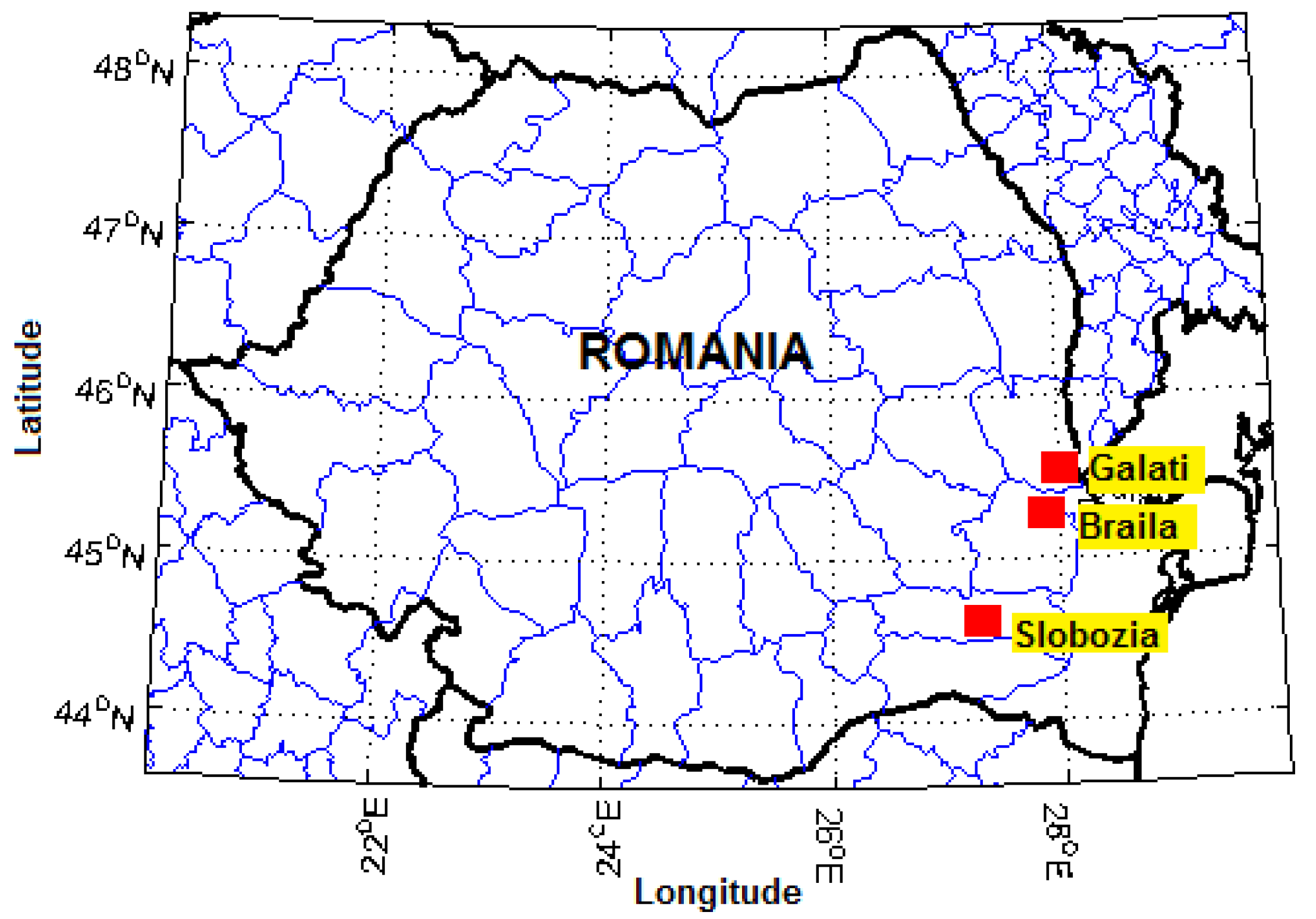
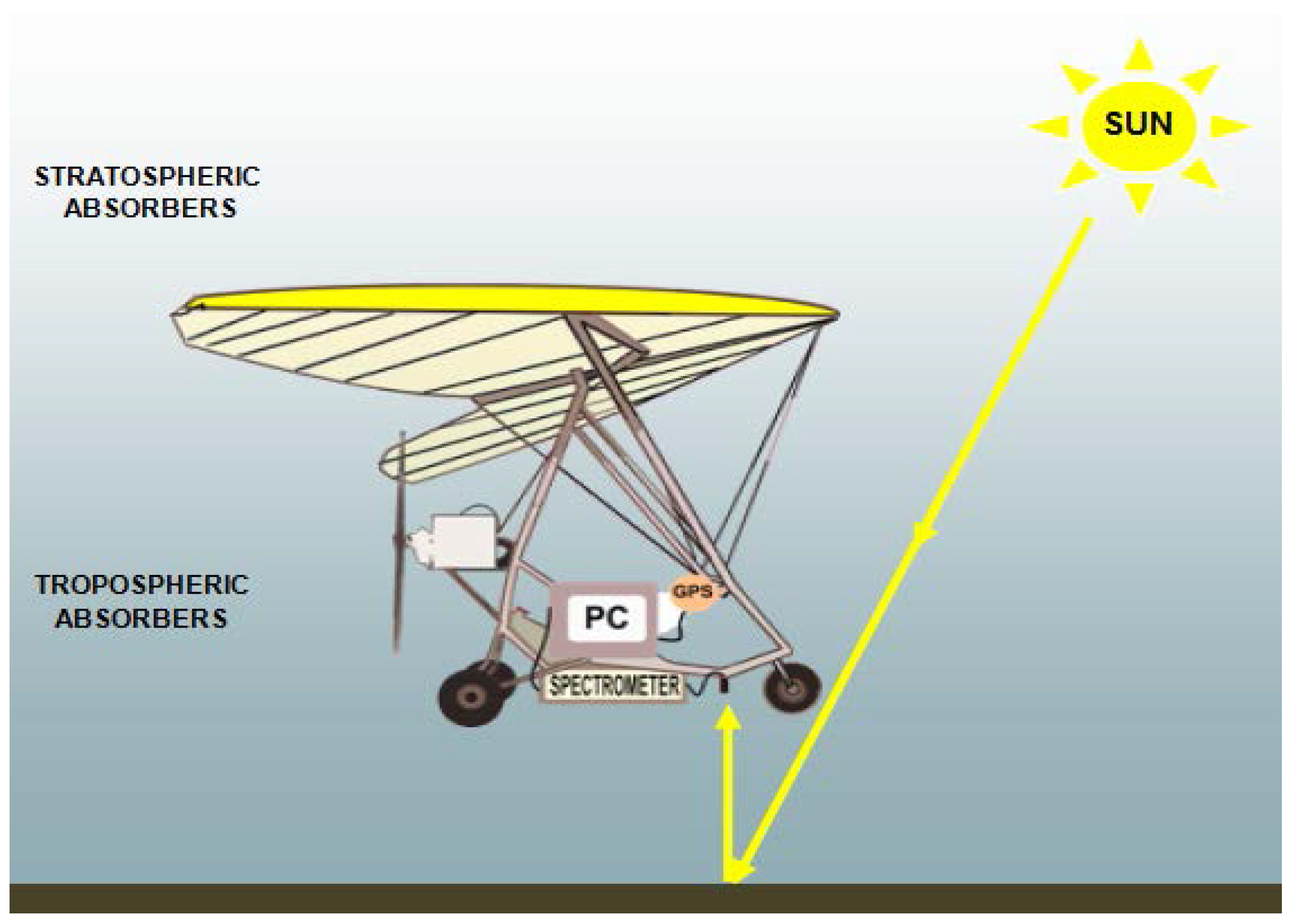
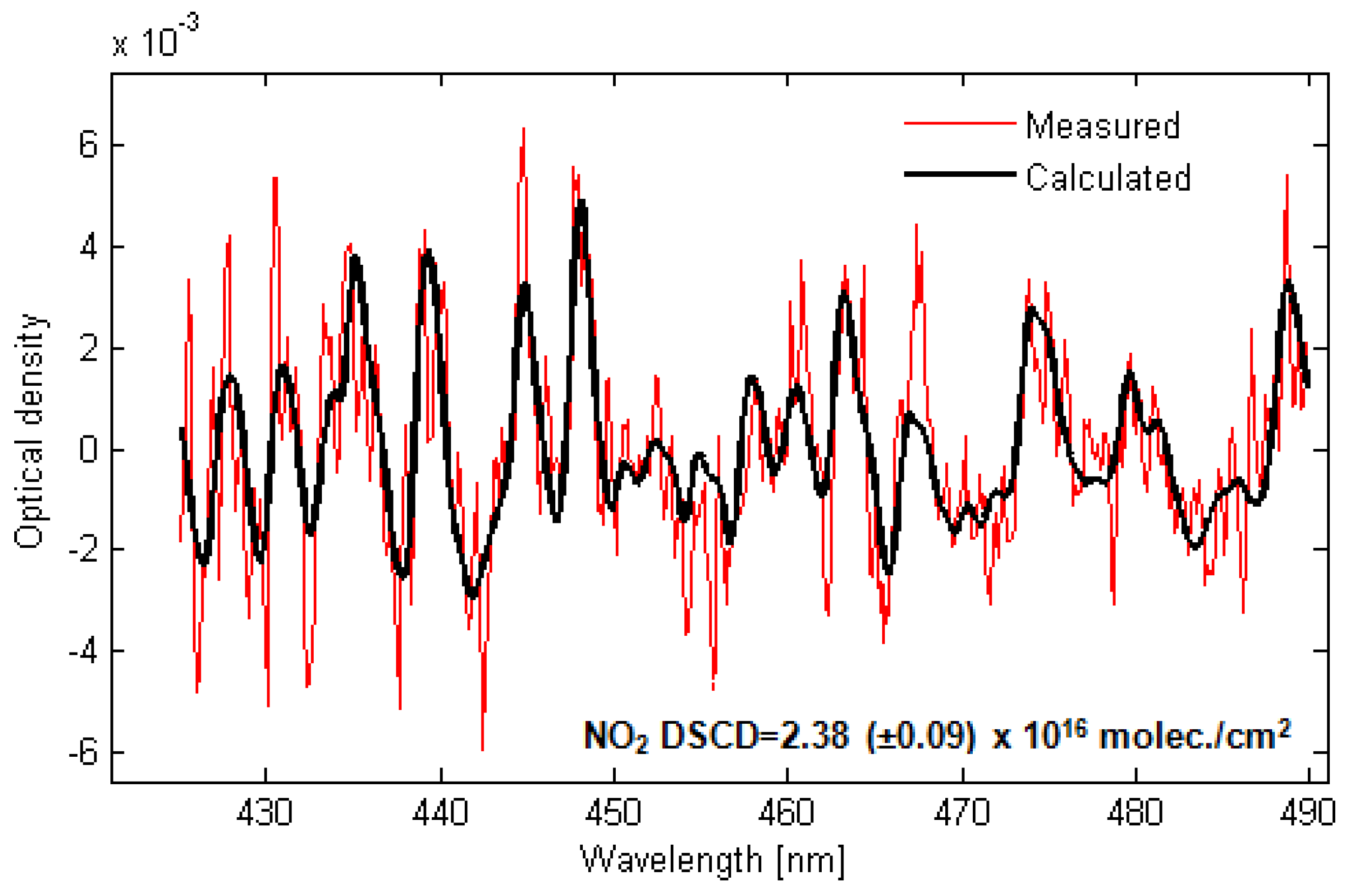
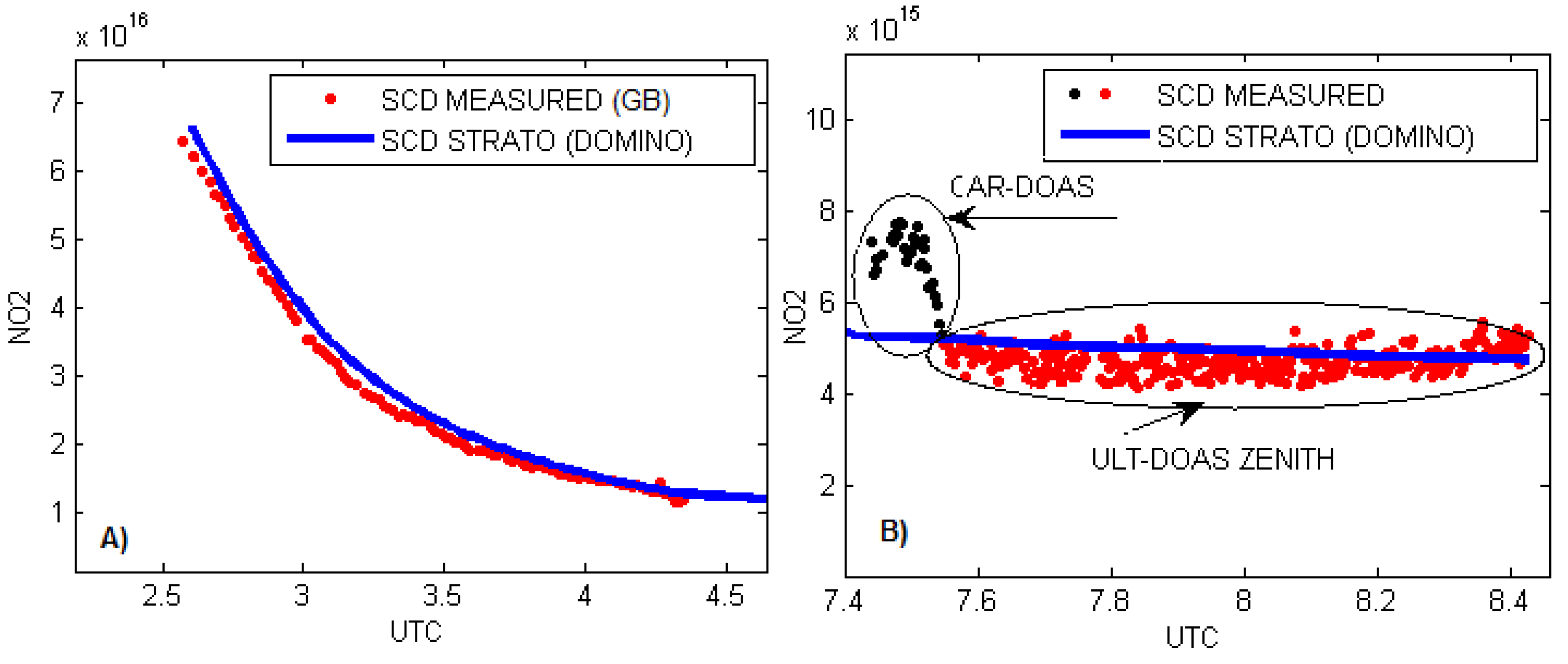
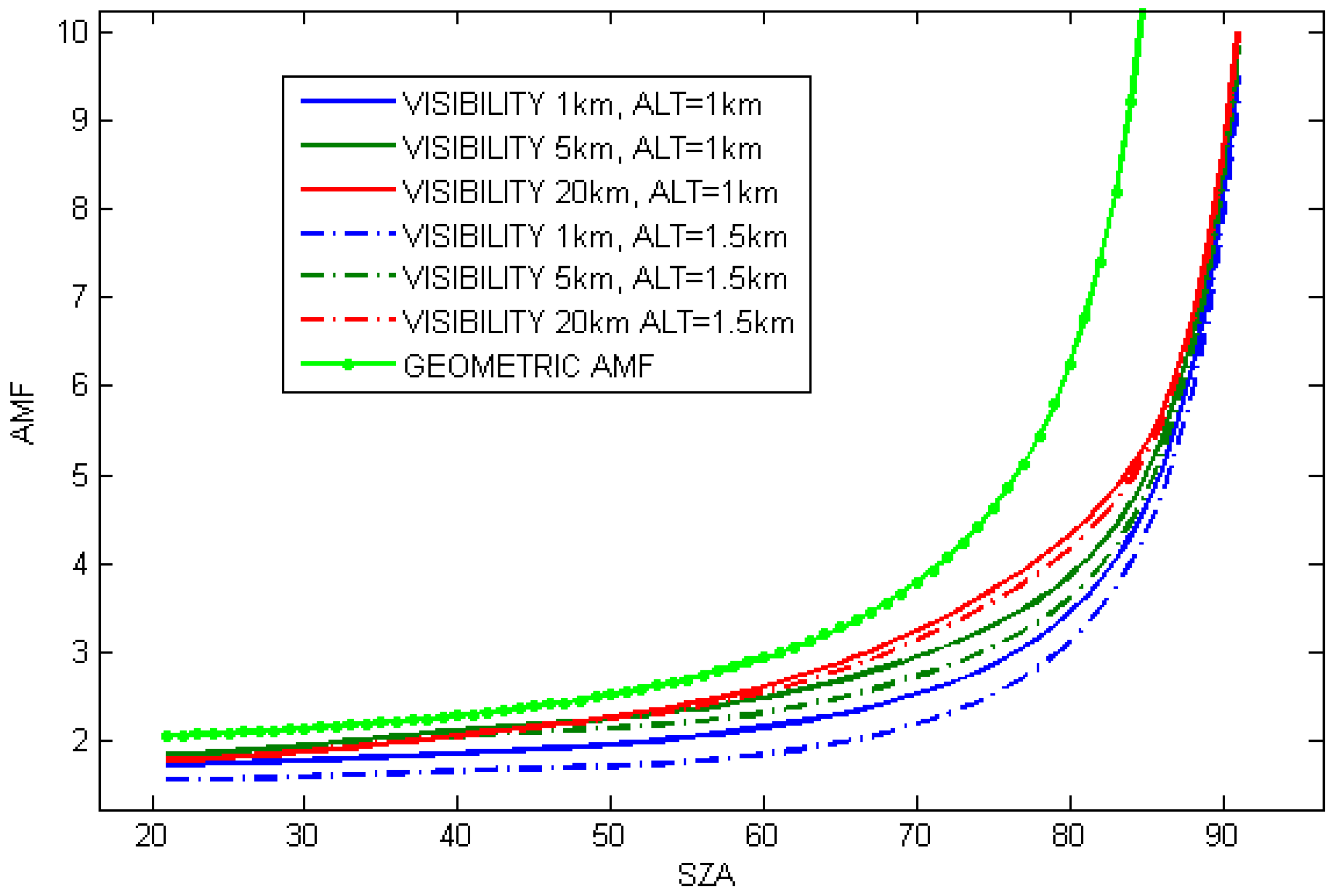
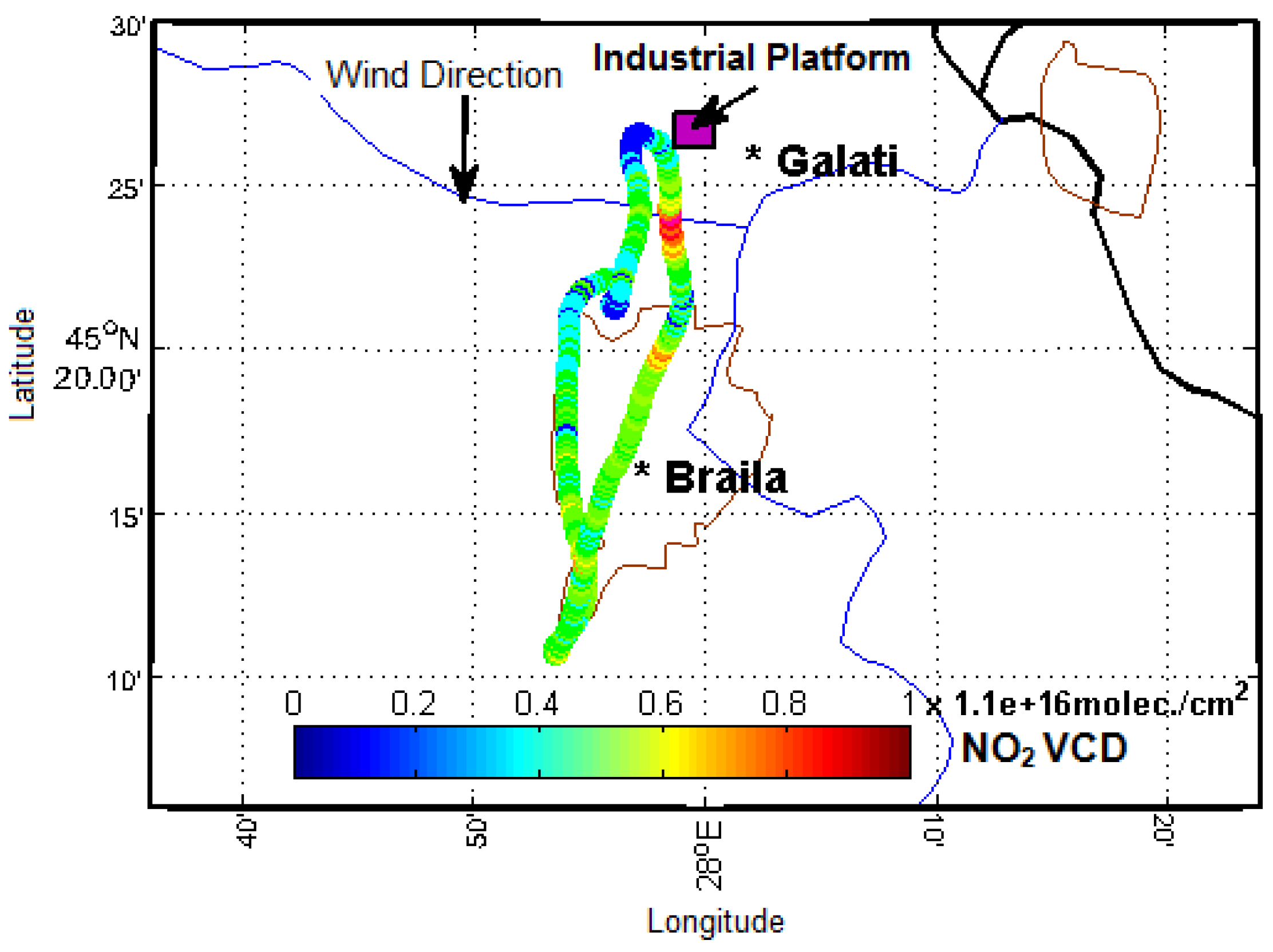
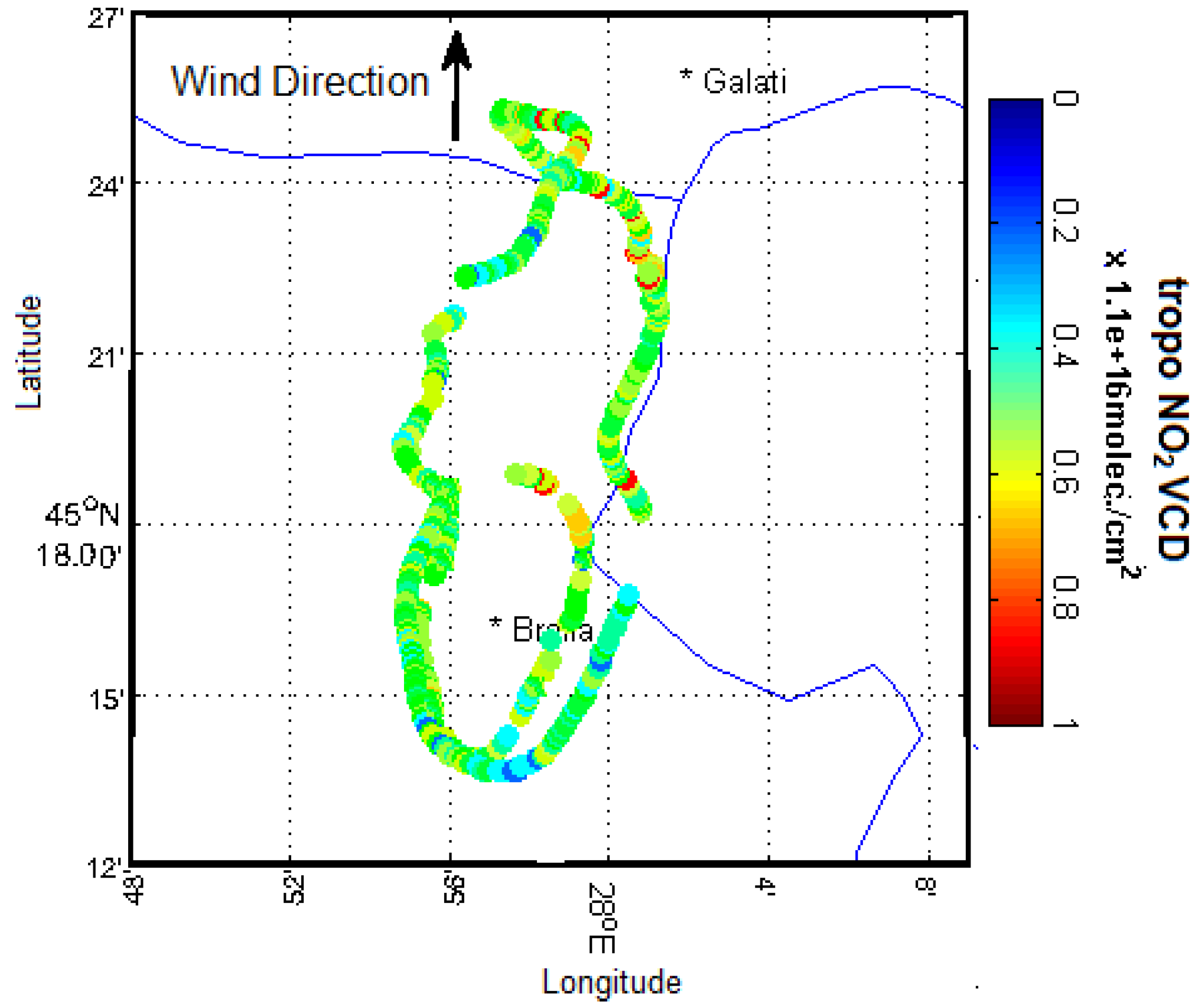
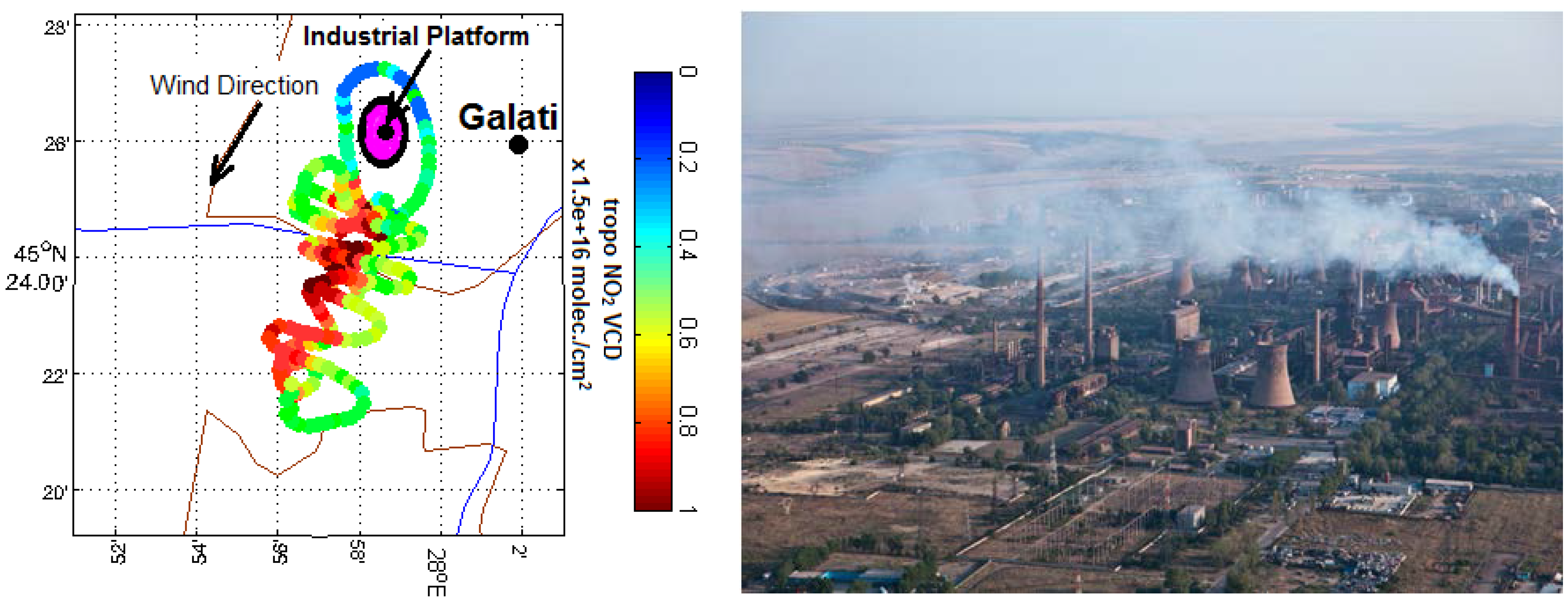
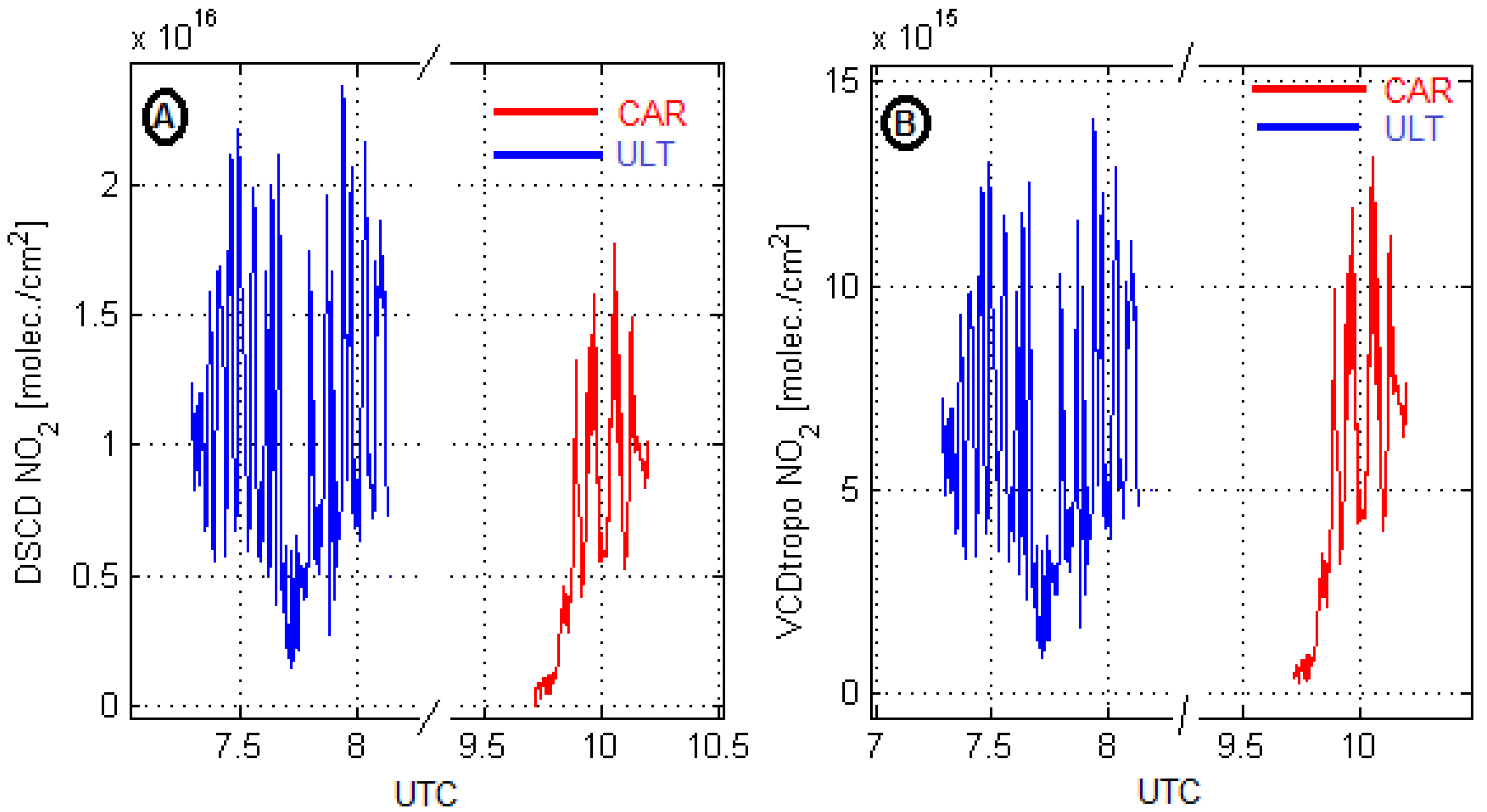
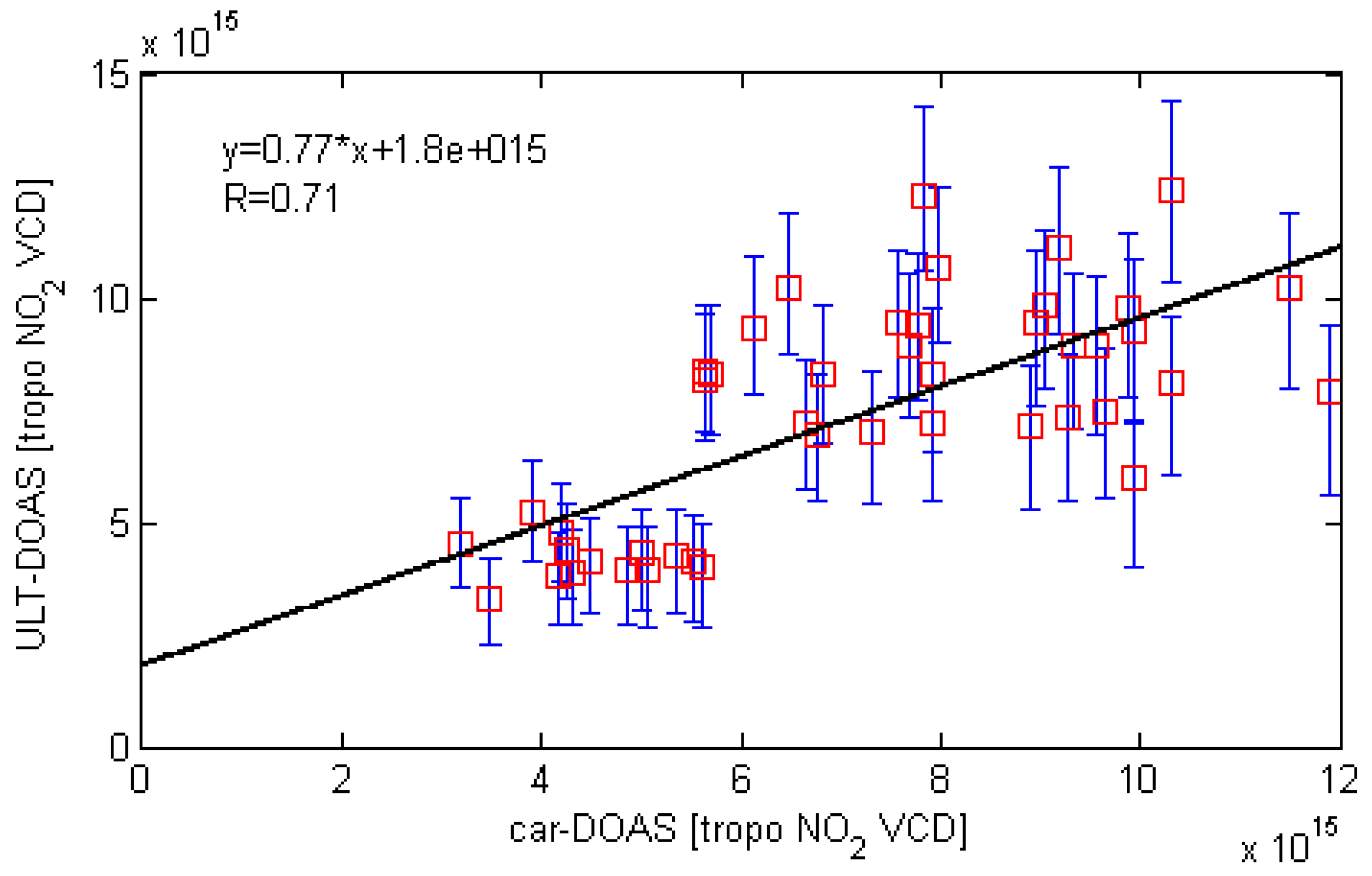
| Day | Time Interval UTC * | Route of ULT-DOAS ** Measurements | NO2 Source Target |
|---|---|---|---|
| 1 September 2011 | 8.31–9.45 | Galati–Braila | Braila urban area |
| 25 August 2012 | 7.53–8.89 | Galati–Braila | Braila urban area |
| 21 July 2014 | 9.51–10.96 | Galati–Slobozia | Slobozia industrial area |
| 13 August 2014 | 7.32–8.19 | Galati | Galati industrial area |
| Day | Orbit Nr. | Overpass Time UTC | Stratospheric VCD [×1015 molecules/cm2] |
|---|---|---|---|
| 1 September 2011 | 37,923 | 11:04:28 | 3.76 |
| 25 August 2012 | 43,151 | 11:11:07 | 3.75 |
| 21 July 2014 | 53,272 | 11:17:36 | 4.14 |
| 13 August 2014 | 53,607 | 11:23:47 | 3.74 |
| Trace Gas | Nitrogen Dioxide | ||
|---|---|---|---|
| wavelength | 440 nm | ||
| flight altitude | 1000 m | 1500 m | |
| albedo | 0.1 | ||
| visibility | 1 km | 5 km | 20 km |
| line of sight | 0° | ||
© 2017 by the authors. Licensee MDPI, Basel, Switzerland. This article is an open access article distributed under the terms and conditions of the Creative Commons Attribution (CC BY) license (http://creativecommons.org/licenses/by/4.0/).
Share and Cite
Constantin, D.-E.; Merlaud, A.; Voiculescu, M.; Dragomir, C.; Georgescu, L.; Hendrick, F.; Pinardi, G.; Van Roozendael, M. Mobile DOAS Observations of Tropospheric NO2 Using an UltraLight Trike and Flux Calculation. Atmosphere 2017, 8, 78. https://doi.org/10.3390/atmos8040078
Constantin D-E, Merlaud A, Voiculescu M, Dragomir C, Georgescu L, Hendrick F, Pinardi G, Van Roozendael M. Mobile DOAS Observations of Tropospheric NO2 Using an UltraLight Trike and Flux Calculation. Atmosphere. 2017; 8(4):78. https://doi.org/10.3390/atmos8040078
Chicago/Turabian StyleConstantin, Daniel-Eduard, Alexis Merlaud, Mirela Voiculescu, Carmelia Dragomir, Lucian Georgescu, Francois Hendrick, Gaia Pinardi, and Michel Van Roozendael. 2017. "Mobile DOAS Observations of Tropospheric NO2 Using an UltraLight Trike and Flux Calculation" Atmosphere 8, no. 4: 78. https://doi.org/10.3390/atmos8040078
APA StyleConstantin, D.-E., Merlaud, A., Voiculescu, M., Dragomir, C., Georgescu, L., Hendrick, F., Pinardi, G., & Van Roozendael, M. (2017). Mobile DOAS Observations of Tropospheric NO2 Using an UltraLight Trike and Flux Calculation. Atmosphere, 8(4), 78. https://doi.org/10.3390/atmos8040078






